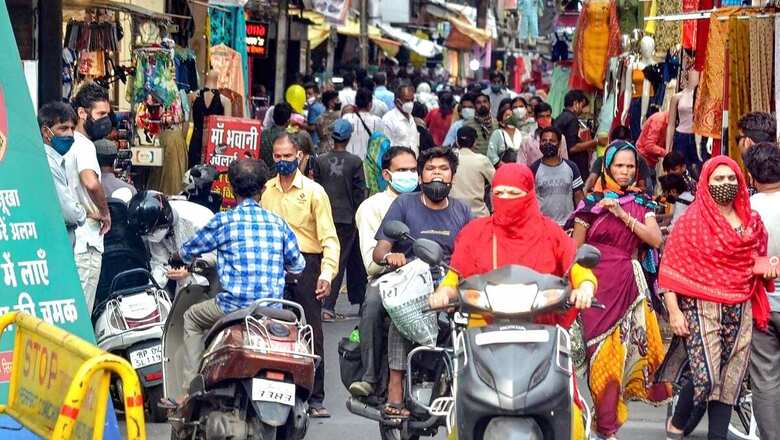
views
The second wave of COVID-19 in India is waning with daily numbers depleting to just over 50,000. Despite the gains made during the month of June 2021, the worst seems far from over with the threat of the menacing Delta variant looming large. India has consistently been clocking high numbers for quite some time now, becoming the second worst-hit country after the US. Earlier this year, complacency had set in amongst the people with social distancing norms and other advisories as mandated by the Government of India being flouted with impunity.
Some of our leaders share the blame too, having made impetuous remarks about the pandemic being contained. This allowed the pandemic to spread rapidly through the Indian hinterland, ravaging towns and villages. Maharashtra, Uttar Pradesh, Delhi, and Karnataka are some of the worst-affected states that have contributed to the record breaking COVID numbers in India. Ill-timed religious gatherings and election rallies became super-spreader events forcing various state governments to impose lockdowns.
Notwithstanding, the onus of the unrestricted spread of the pandemic rests squarely on the general public who cannot shirk responsibility from this avoidable scenario. Many people saw no merit in continuing with safety norms, choosing instead to blatantly disregard many of these advisories on account of limited perceived health benefits. The “Prevention Paradox” perhaps is a major factor for the upsurge in the total number of cases despite having several advisories set out to follow—no mass gatherings, social distancing norms, wearing masks, and washing hands regularly.
Epidemiologist Geoffrey Rose used the term Prevention Paradox in 1981 and posited it as the causal link between risk quantification and health intervention strategies as enacted by policymakers. This is not an alien phenomenon. Usually, in public health, it is common to witness such complacency to not adhere to preventive measures implemented at the population level. Prevention Paradox occurs because many large-scale health interventions do not have a direct bearing on the health of most people. Public opinion often trivialises the seriousness of the disease under surveillance and frequently doubts the efficacy of the implemented preventive measures, even to the extent of belittling it as being wasteful.
ALSO READ | What Will The COVID Third Wave Be Like? An Expert Answers Your Queries
COVID-induced lockdowns have had a debilitating impact on most businesses and life in general and those not affected directly by the contagion feel that their freedom has been unnecessarily curtailed. The weakening virulence of the pandemic enabled primarily by lockdown measures and other restrictions have driven public opinion towards early resumption of normalcy, in spite of a large number of cases being reported daily. This, in effect, is the Prevention Paradox the government is facing.
Traditional economists use the term “Homo Economicus” to describe humans as individuals who take rational decisions. They believe that the rational man is self-interested, aware of his needs and maximises his utility by making rational choices. This, however, seems far too ideal in the real world as it is difficult to predict human behaviour. It draws on psychology and economics to explain unpredictable and irrational behaviours. Though, bold policies usually are not popular amongst citizenry, according to behavioural economics, people are unable to make rational choices due to lack of self-control, information, and the inherent tendency to adopt the path of least resistance. The deliberate violation of COVID-prevention protocols by a large section of the society, in spite of a raging pandemic, aptly corroborates this well-accepted theory.
It is important to highlight that there are two fundamental risk mitigation strategies adopted by policymakers, which are aimed at the individual and the population level. Though not competing, both these approaches aim to identify and control the incidence of a disease. Although, the targeted individual preventive strategy involves physicians concentrating on high-risk and susceptible individuals, it fails to impact the larger population exposed to moderate risk. In addition to the hassle of identifying high-risk subjects and associated costs, the individual approach is usually temporary as it does not address the root cause or the genesis of the health risk.
On the other hand, population-focused strategies control the incidence of disease by focusing on the heterogeneity of exposure of the population. These are aimed at controlling the determinants of incidence to lower the mean level of risk factors, thereby, shifting the distribution of exposure in a desirable direction. Benefits to a subject, however, are relatively small thus reducing the motivation of individuals. Regardless, mass prevention approaches, trying to alter social norms of the society, have huge potential.
ALSO READ | Understanding the Ways in Which SARS-CoV-2 Spreads Could Hold the Key to Future Treatment
Public health aims to benefit the maximum number of people and the government in its stewardship role can design policies that are cost effective in addressing identified risk behaviour in the population by targeted policy intervention strategies. Though costly, lockdown is a population-based intervention strategy, which has proven to be extremely effective in arresting the spread of the COVID-19 pandemic. Case in point—COVID numbers in the state of Delhi. At the peak of the second wave in April 2021, Delhi recorded a daily caseload of more than 28,000 positive infections with the health infrastructure in the national capital getting overwhelmed, but more than a month of lockdown saw these distressing figures slump to below 115 with a positivity rate of 0.15 per cent. Lockdown in other Indian states like Maharashtra and Bengal, too, resulted in diminishing the menacing effect of COVID-19.
Indeed, the collapsing public health infrastructure in the national capital and other Indian states could only be salvaged by a population-based risk mitigation strategy, especially in the absence of a comprehensive vaccination drive. It is not surprising yet again to see state governments tightening unlocking rules triggered by the surge in cases caused by the Delta variant.
Interventions by policymakers are aimed at improving the health of the population. These strategic interventions have a direct causal relation to the desired attainment of improved population health status. The effectiveness of these cost-effective measures can only be realised by the shared responsibility by both individuals and governments. Though delayed, the government on its part has taken the requisite steps to arrest the spread of the pandemic including securing enough vaccines to vaccinate the whole country by December 2021. For the economy to open up with easing out of various restrictions as has been done in the US and EU, it is time that the Indian public too, realise their social responsibilities in arresting the pandemic.
This article was first published on ORF.
Read all the Latest News, Breaking News and Coronavirus News here.















Comments
0 comment